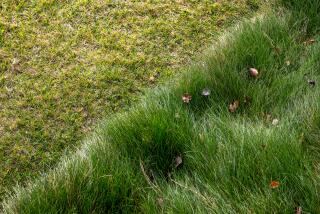Homegrown lemon grass: two varieties of a singular taste
- Share via
One of the stands of lemon grass in the middle of the Vermont Square Community Garden is in full flower now, a somewhat unusual occurrence. It’s not a particularly attractive phase for the plants, which look like overgrown weeds on their last legs. Fortunately the plants’ useful life isn’t over; the stage is simply another turn of the wheel, the clumps of lemon grass scattering seeds to expand their reach.
The lemon grass is in a communal plot, available to all the gardeners to use. The aromatic grass exudes a citrus scent that comes out in cooking. It’s a bright yet subtly floral blend of lemon, lime, ginger and grass -- the iconic backdrop for the Thai hot-and-sour soup called tom yum.
Vermont Square gardener Makadu DeBeet, a native of the Virgin Islands, uses the lemon grass for a relaxing tea. He steams the leaves and stalk, then adds honey or sugar.
“It makes you sleepy,” he says. “It’s good for getting kids to go to sleep. You can boil it, but steaming is better.”
Cultivated widely throughout Latin America for herbal medicines, lemon grass originated in Southeast Asia and emerged in the cuisines of Sri Lanka, Malaysia and Thailand. The stalks can be skewered for use as flavor enhancers in grilling, the leaves can be tied into a bundle for tea, and the soft white base can be sliced, diced or pounded into a paste. Though the tough stalk is inedible, its flavor is without substitute.
Two varieties are commonly found in nurseries: West Indian lemon grass (Cymbopogon citratus) and East Indian lemon grass (Cymbopogon flexuosus). Both can be used for cooking, but the thicker West Indian variety is better.
You can start a new plant by snipping a stalk from a plant in the ground or from lemon grass bought fresh from the produce aisle. Trim off the top few inches, put the base in water that is changed daily and wait a few weeks for roots to grow.
Seedlings also can be found in garden stores including Mimosa Nursery, a tropical plants specialist in L.A. You can get seeds for the East Indian variety from online suppliers such as Johnny’s Selected Seeds.
With room to expand and a humid environment, lemon grass will produce stalks within four months and will continue producing for about four years. When harvesting, clip only one or two stalks every few months from the outside, slicing at the soil line.
Lemongrass adapts well to containers, but be sure to use a large pot if the site is in full sun.
The Global Garden, our series looking at multicultural L.A. through the lens of its landscapes, appears here on Tuesdays. We welcome story suggestions at [email protected].
You can find L.A. at Home on Facebook, Twitter and Pinterest.






